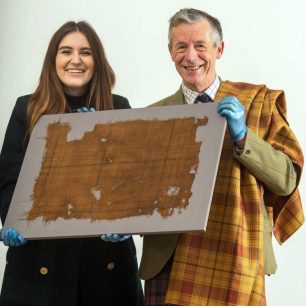The Fascinating History Of Scottish Tartan

The history of Scottish tartan is as long and complex as the pattern itself. What began as a simple garment design with very little meaning at all, later became a symbol of rebellion and a battle uniform.
According to the Scottish Tartans Museum, tartan attire became synonymous with the Scottish Highlands in the 17th and 18th centuries and was an integral part of Highland dress.
By the mid-18th century, to wear tartan was to signify an allegiance to Charles Edward Stuart, known to Scots as Bonnie Prince Charlie. In 1745, Bonnie Prince Charlie led an army of tartan-clad rebels called the Jacobites into England for a series of uprisings called the Jacobite Risings – this was his attempt to reclaim the throne for his father.
The Jacobites were defeated during the Battle of Culloden in 1746, after which the British government banned Highland Dress through the Act of Proscription. It’s a misconception that tartan itself was banned when, in fact, Highland dress was prohibited, which at this point incorporated a lot of tartan.
Highlanders were forced into Lowland dress and forbidden from wearing many tartaned clothing including the phillabeg (little warp, which looks like a kilt), trews (tartan trousers), and tartan-patterned coats. Government soldiers were explicitly excluded from the ban, while women and young girls implicitly so.
This was a general attempt to suppress Scottish culture and prevent future uprisings. The Act of Proscription was later repealed in 1782.
What about clan tartan?
It wasn’t until around 1815 that tartan’s association with different Scottish clans and family names became a concept. This is probably a lot later than you imagined… we’re sorry to break this to you, but that’s because the notion of clan tartan is now considered an elaborate work of fiction by most historians.
Early tartans may have been linked to specific regions, but this is more likely due to the availability of local resource such as dyes and the simple fact that independent regional weavers – like any other artist and craftsperson – had their favourite patterns and bestsellers. They also made their own clothes for their families, which would have created a reoccurrence of patterns that held little to no substantial meaning.
If patterns were ever attributed to clan names, they can only be traced back to the early 19th century and to William Wilson & Sons of Bannockburn, a popular weaving firm of the time near Stirling. However, this is still much later than some of the boldest claims state.
The reality is that the Highland dress ban halted much of the original tartan weaving practice. By the time the repeal was made, enthusiasm for tartan in Scotland had been stomped out by enforcement. During this time, many of the original weavers died and with them the details of the original tartans.
However, when The Highland Society of London were attempting to preserve what remained of the old patterns, they mistakenly recorded them as belonging to specific family names. This fed into the Highland Revival – a period of time following the repeal where Highland dress was returning in a new and big way.
Historian Peter MacDonald further explains Scottish tartan history in the video below. This was part of the Tartan exhibition in V&A Dundee earlier this year.
Most of the “clan” tartan worn today was actually invented by two English brothers named John Carter Allen and Charles Manning Allen. The con-men changed their names multiple times over the years before settling on Sobieski Stuart, which was chosen to suit their claims of descending from Bonnie Prince Charlie.
They also told tall tales of finding a manuscript called the “Vestiarium Scoticum” – wardrobe of the Scots – which listed a number of tartans allegedly connected to particular clans dating back to the 1580s.
Most of this manuscript was false, but it painted such a cohesively idyllic fantasy of Highland life which society, and ultimately the world, couldn’t help but buy into. The pair went onto produce designs that were either loosely inspired by what remained of any old designs or they created entirely new patterns.
As the commercial market opened, Highland dress was no longer a crime but now an undeniably bold fashion statement. It was also easier to sell tartan if each had a name rather than a number, so people began buying patterns in their names.
When King George IV visited Scotland in 1822 – the first time a monarch had come to Scotland since 1641 – he appeared in full Highland dress. As you can imagine, this didn’t go down well with quite a number of Scots, all things considered.
However, it did support this new narrative of Scotland as a brand romantically wrapped in tartan, which still sells today.
Evidently, the history of Scotland’s tartan is murkier than depths of Loch Ness and far more complicated than first meets the eye.
The oldest Scottish tartan
Around 40 years ago, a long-lost piece of tartan was discovered in a Glen Affric peat bog.
Radiocarbon testing dated the Glen Affric tartan piece between 1500 and 1600 – this would have been during the rule of the Stuart monarchs, including Mary, Queen of Scots.
The Glen Affric tartan is considered to be the oldest known piece of Scottish tartan. It’s multiple colours and stripes of varying size, distinguish it from the likes of the so-called Falkirk tartan.
The Falkirk tartan is often mistakenly hailed as the oldest Scottish tartan; however, it doesn’t qualify as a “true tartan” due to it’s simpler check pattern and undyed yarn.
True tartan is defined by a set of lines, both broad and narrow and of two or more colours. Tartan must be woven in such a way as to produce the same a symmetrical pattern both horizontally and vertically.
Tartan is a global design
These days tartan may be synonymous with Scotland, but would you believe that it is not unique to this bonnie land?
The oldest piece of tartan ever discovered was in China and it’s approximately 3,000 years old. Various other iterations of tartan design have also been found around the globe.
Essentially, anywhere in the world that was historically weaving cloth, people were creating tartan designs. Here in Scotland, tartan just so happened to catch on, providing cultural and political significance before becoming a pretty gift-wrap.
What is plaid?
We forgive our American readers for mistaking tartan for “plaid”. This is a confused interpretation, which probably wasn’t helped by an already muddled Scottish tartan history.
Freezing Highland temperatures often required a woollen shawl or wrap. This was known as a plaid or plaidie, which is Scots Gaelic for “blanket”.
In its infancy, tartan although not fully established was becoming increasingly Scottish, so a number of these plaids will have been tartan. Evidence supports this as tartan cloth has been found in Scotland dating from the third or fourth century.
Eventually, Highlanders began to gather these large wraps of fabric into folds, belting them at the waist. This is known as the belted plaid. In Gaelic it was called either feileadh-mór (great wrap) or breacan-an-feileadh (tartan wrap). Today, they are sometimes called “great kilts”.
Then came the Phillabeg, which is the Anglicized spelling of the Gaelic feileadh-beag, meaning “little wrap”. It was essentially shorter than the “great kilt”.
Finally, today’s most popular tartan item was born – the tailored kilt. This differs from the phillabeg in that instead of being gathered and belted, the pleats are actually sewn down.
The kilt is what you will see today at Scottish weddings and other formal events. Typically, kilts are of tartan design, but there are plenty of non-tartan options.
And “plaid shirts” are likely just mass produced checked designs opposed to true tartan.






